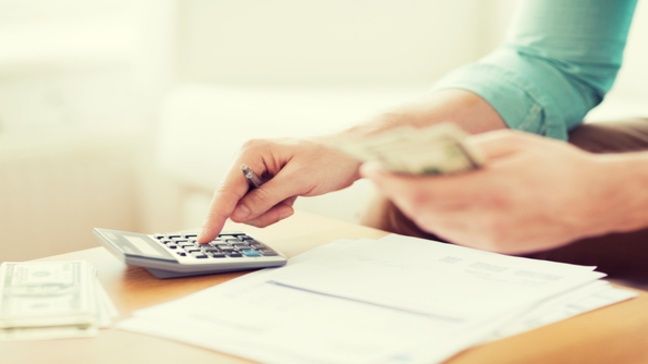Previous-school private finance books inform you that if you happen to simply create a price range and stick with it, then — POOF! — all of your cash issues will probably be solved immediately.
However anyone who has ever tried budgeting is aware of that’s not the way it works. Even if you happen to jot down each penny you spend for 30 days, and attempt to keep inside your means, generally issues don’t at all times go as deliberate and you could end up spending a bit greater than you initially budgeted for.
Over the previous 5 years, I’ve performed quite a lot of trial and error in relation to budgeting. I’ve set month-to-month budgets, annual budgets, and weekly budgets. I’ve tracked my spending utilizing paper and pencil, labored off of spreadsheets, and downloaded a number of apps to assist in my quest to personal my price range
So, at the moment, I’m going to point out you what truly works. Whereas every particular person’s journey will probably be completely different, these budgeting ideas are actually meant as a blueprint to get the ball rolling on managing your spending.
Step 1: Cease budgeting. Provide you with a easy spending plan as an alternative
Okay, I do know you in all probability learn that and thought, “however that is an article about learn how to begin budgeting.” I do know… however hear me out.
Month-to-month budgets are sometimes ineffective as a result of we are likely to underestimate our bills. I by no means sustain with them, and I’m a monetary blogger — a complete nerd about these things. So I don’t anticipate you to.
There are some stuff you simply should pay for every month, like hire (or a mortgage, when you’ve got one), transportation, utilities, meals, and debt funds. Then there are miscellaneous bills, like automotive repairs, residence enhancements, holidays, and insurance coverage funds.
For you, these miscellaneous bills could solely be 10% or so of your complete spending. However for me (particularly after changing into a house owner) they’ve crept as much as extra like 30% (residence repairs and renovations aren’t low cost).
And right here’s what this implies. Accounting for, and “pre-spending,” each greenback you make could be a monetary mistake. If I take my annual take-home pay (aka my wage after taxes), divide it by 12, and proceed to spend that quantity each month, I’m going to be in hassle when that surprising automotive restore expense comes up or once I’m doing my vacation procuring.
So what you should do is cease obsessing over the detailed, track-every-penny budgets you’ve at all times been instructed have been the answer and as an alternative, implement a easy spending plan.
What is an easy spending plan?
A easy spending plan is a straightforward technique to price range that helps you lower your expenses, get out of debt, and pay your payments on time — whereas nonetheless permitting you the liberty to spend cash on stuff you worth.
As an alternative of specializing in pre-spending each greenback tightly, a easy spending plan emphasizes the necessity to recalibrate your price range every month (aka it’s fluid). Why? As a result of bills can go up and down, particularly now that inflation is at its highest level in 40 years, and issues are getting pricier by the day.
And I’m not the one one who says this. I as soon as learn in a private finance publication that one of the simplest ways to cut back monetary stress is — you guessed it — to cease budgeting.
Right here’s the quote for reference:
“Cash (or its lack) is the nation’s commonest supply of stress, reviews the American Psychological Affiliation. Making an in depth price range — a extensively suggested repair — solely makes issues worse, says Cleveland monetary planner Kenneth Robinson, based mostly on a decade of labor with purchasers; the issue is that folks hate to consider the place they’ll want to chop again.”
In different phrases, a inflexible month-to-month price range is principally a recipe for catastrophe. You need to take into consideration every month as a clean canvas, the place you alter your spending as wanted. In any other case, you’ll get annoyed and probably go off the rails so far as your price range is worried.
Step 2: Monitor your spending — the straightforward manner

Do you debit? In that case, you’re already utilizing a useful price range device | Picture supply: Halfpoint/Shutterstock.com
Neglect about manually monitoring each penny. The objective is to arrange a system that retains monitor of your entire spending digitally, with none extra work from you, so you possibly can entry it if and when you should.
You are able to do this simply through the use of the single-card methodology. That is whenever you use only a single debit or bank card for your entire purchases — or as near all of them as you possibly can — and let know-how do all of the monitoring for you.
Among the best methods know-how may help your pockets is by eliminating the necessity to use money, and subsequently, eliminating the necessity to preserve monitor of our money bills.
Now, that is counterintuitive to what quite a lot of old-school monetary gurus say about utilizing money as a mechanism that will help you spend much less. Whereas that’s partly true, the very fact is that money also can get misplaced or stolen.
And, extra importantly, money is being phased out by the day. Digital funds are right here, prefer it or not, and the occasions you want money (for something) over a debit or bank card are fewer and fewer.
However the perfect factor about utilizing a credit score or debit card is that you simply routinely have a document of your entire spending.
So do you have to use credit score or debit?
When you’ve got a bent to purchase issues first and determine how one can pay for them later, stick with a debit card, as that may preserve you out of economic hassle.
However if you happen to’re comfy with a credit score line and solely charging what you possibly can pay again in full every month, bank cards are extra helpful than most debit playing cards — particularly if tagging and categorizing your purchases is necessary to you.
With most playing cards, you possibly can even export your transactions to a spreadsheet —which for the nerds like me, is the place the enjoyable begins. This spending report will be of main assist when getting all the way down to the nitty-gritty of budgeting, supplying you with a document of each penny that you simply spend utilizing your card.
I can consider one card, particularly, the Chase Freedom Flex℠, that makes it extremely straightforward to maintain monitor of your spending, particularly in relation to your quarterly 5% bonus classes. By logging onto Chase Final Rewards®, you possibly can simply see how a lot cash you’ve dished out in every of the classes that you simply activate, in addition to how a lot of your $1,500 spending restrict you’ve left. If you’re searching for a full image of your spending, Chase provides that as effectively.
Higher but, many bank card corporations reward you only for making purchases with their card. This usually comes within the type of money again or journey rewards, which may help you set some a refund into your checking account or assist cowl purchases to your subsequent trip.
If you’re contemplating a bank card however your credit score rating is lower than good, we suggest the Capital One QuicksilverOne Money Rewards Credit score Card. This card provides 1.5% money again on each buy, which you’ll redeem for money, reward playing cards, or assertion credit, permitting you to take advantage of out of each greenback spent.
Nevertheless, what I feel is most useful, particularly for many who are first-time cardholders, is the flexibility to entry your month-to-month recurring transactions. This makes budgeting or eliminating extra spending simpler than ever.
Learn extra: One of the best bank cards proper now
Use budgeting apps
If the single-card methodology isn’t for you, strive utilizing a budgeting app. As an alternative of manually evaluating your spending to be sure to keep on monitor, budgeting apps monitor and analyze your spending. This, in flip, could make it simpler so that you can see the place your cash goes, and changes you can also make to enhance your money movement.
One in all our favourite budgeting apps is Mint, which connects to all of your monetary accounts that will help you monitor your spending. The Mint app means that you can set monetary objectives and also you’ll obtain updates and reviews to let you know the way a lot you’ve progressed.
Private Capital is one other nice budgeting app to take a look at. This app is very helpful if you wish to add investing to your monetary technique. As with Mint, you’ll hyperlink your monetary accounts to Private Capital and anticipate the app to begin gathering knowledge from the cash you’re spending. However whilst you’re budgeting and managing your cash, it’s also possible to make the most of Private Capital’s knowledgeable recommendation to construct an funding portfolio.
Step 3: Know your mounted bills
Establishing a private finance app or downloading your entire bank card transactions is nice for historic evaluation of the place your entire cash goes.
Wanting ahead, nevertheless, this knowledge is much less necessary. What you should know are your mounted month-to-month bills. These embrace issues like:
- Your hire or mortgage.
- Utilities.
- Insurance coverage.
- Mortgage funds (scholar loans, auto loans, and so forth.).
- Minimal bank card funds.
- Desired financial savings, investments, or extra debt funds.
That final level is very necessary. It’s important that you simply calculate how a lot you need to save, make investments, or use to pay down debt first. To search out what’s left, do the next:
- Complete your mounted month-to-month bills.
- Determine your month-to-month take-home pay.
- Subtract your mounted bills out of your take-home pay.
That is what’s left to spend, additionally known as your “spending allowance” (which we’ll speak about under). You’ll be able to spend this on no matter: take-out, wine, journey — principally something that makes your coronary heart sing.
After all, if one thing huge occurs, you could have to spend cash on that and have much less for enjoyable stuff. That sucks, nevertheless it’s additionally why it is best to at all times have an emergency fund.
Then there’s the difficulty of getting no leftover cash. What do you do then? Take deep breaths — you bought this. If cash is tight, it’s possible there received’t be a lot (or any) left to spend after you’ve laid out your mounted month-to-month bills and what you hope to avoid wasting. Within the brief time period, you possibly can cut back however not get rid of your financial savings objectives, whereas on the similar time trimming spending.
When trimming bills, take into consideration the massive stuff, like housing and your earnings. Listed below are some ideas that will help you lower your expenses in these areas:
Step 4: Put all of your cash on autopilot

Automation means much less of this | Picture supply: Hananeko_Studio/Shutterstock.com
I first examine placing my cash on autopilot over 10 years in the past in “The Automated Millionaire” by David Bach. Your complete e-book is dedicated to organising automated methods to handle and make investments your cash. This does two superb issues:
- It eliminates fear. You cease losing time eager about silly issues like, “Did I pay the electrical invoice this month?”
- It protects you from your self. Automated funds make it tougher so that you can sabotage your cash. No extra late bank card funds (and the related charges and harm to your credit score rating). No extra skipped IRA contributions. And on and on.
The thought of automating your funds isn’t new. Actually, one other author who has taken the concept of automated funds to the following stage is behavioral finance guru Ramit Sethi.
He lays out easy plans for automating your private funds on each his weblog, “I Will Educate You To Be Wealthy”, and in his e-book by the identical identify. He’s a vocal advocate of what so many different monetary “consultants” for some cause refuse to acknowledge. We don’t need individuals telling us to only “arrange a price range” and “reduce on lattes” — the latter is a direct jab at Bach, who trademarked the time period “Latte Issue” to explain how a each day espresso behavior can eat into long-term wealth.
As an alternative, we wish to have the ability to spend our cash consciously, even when that features issues we wish. And the important thing to that’s automation.
Learn extra: Put your cash on autopilot
Step 5: Spend the remainder with out fear through the use of a spending allowance
Any extra cash that you’ve got left after your month-to-month bills and financial savings is what I name your spending allowance. It’s how a lot you possibly can spend this month (on no matter you need) with out worrying.
Utilizing no matter methodology you’ve arrange for autopilot spend monitoring, you possibly can preserve a easy eye on how a lot of your spending allowance you’ve used for this month. For instance, through the use of the single-card methodology for your entire day-to-day spending.
That is what I do: my family’s spending allowance is $2,500 a month. I eye our bank card stability all through the month, and if it reaches $2,000 too far earlier than the top of the month, for instance, I do know it’s time to ramp down the spending a bit.
Abstract
Right here’s the principle takeaway of this text: budgets are overrated. They create stress and, many occasions, we merely don’t keep on with them.
As an alternative, strive having a spending plan in place, and undertake a fluid method to cash that means that you can alter your spending as you go.
Lastly, strive automating all of your funds. That manner, you’ll have an general view of the place your cash goes and mean you can assess opportunistic methods to avoid wasting or make investments.
Learn extra:

